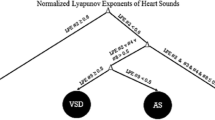Abstract
To develop a digital algorithm that detects first and second heart sounds, defines the systole and diastole, and characterises the systolic murmur. Heart sounds were recorded in 300 children with a cardiac murmur, using an electronic stethoscope. A Digital algorithm was developed for detection of first and second heart sounds. R-waves and T-waves in the electrocardiography were used as references for detection. The sound signal analysis was carried out using the short-time Fourier transform. The first heart sound detection rate, with reference to the R-wave, was 100% within 0.05–0.2R-R interval. The second heart sound detection rate between the end of the T-wave and the 0.6R-R interval was 97%. The systolic and diastolic phases of the cardiac cycle could be identified. Because of the overlap between heart sounds and murmur a systolic segment between the first and second heart sounds (20–70%) was selected for murmur analysis. The maximum intensity of the systolic murmur, its average frequency, and the mean spectral power were quantified. The frequency at the point with the highest sound intensity in the spectrum and its time from the first heart sound, the highest frequency, and frequency range were also determined. This method will serve as the foundation for computer-based detection of heart sounds and the characterisation of cardiac murmurs.
Similar content being viewed by others
References
Abella, M., J. Formolo, and D. G. Penney. Comparison of the acoustic properties of six popular stethoscopes. J. Acoust. Soc. Am. 91(4 Pt 1):2224-2228, 1992.
Balster, D. A., et al. Digital acoustic analysis of precordial innocent versus ventricular septal defect murmurs in children. Am. J. Cardiol. 79(11):1552–1555, 1997.
Baranek, H. L., et al. Automatic detection of sounds and murmurs in patients with Ionescu–Shiley aortic bioprostheses. Med. Biol. Eng. Comput. 27(5):449–455, 1989.
Bulgrin, J. R., et al. Comparison of short-time Fourier, wavelet and time-domain analyses of intracardiac sounds. Biomed. Sci. Instrum. 29:465–472, 1993.
Donnerstein, R. L. Continuous spectral analysis of heart murmurs for evaluating stenotic cardiac lesions. Am. J. Cardiol. 64(10):625–630, 1989.
Iwata, A., et al. Algorithm for detecting the first and the second heart sounds by spectral tracking. Med. Biol. Eng. Comput. 18(1):19–26, 1980.
Kindig, J. R., et al. Acoustical performance of the stethoscope: A comparative analysis. Am. Heart J. 104(2 Pt 1):269–275, 1982.
Lukkarinen, S., et al. A new phonocardiographic recording system. Computer Cardiol. 24:117–120, 1997.
Maurice, B., E. E. Rappaport, B. Haward, and M. D. Sprague. The acoustic stethoscope and the electrical amplifying stethoscope and stethograph. Am. Heart J. 21(3):257–318, 1940.
Nygards, M., and L. Sornmo. Delineation of the QRS complex using the envelope of the E.C.G. Med. Biol. Eng. Comput. Sep;21(5):538–547, 1983.
Nygaard, H., et al. Assessing the severity of aortic valve stenosis by spectral analysis of cardiac murmurs (spectral vibrocardiography). Part I: Technical aspects. J. Heart Valve Dis. 2(4):454–467, 1993.
Nygaard, H., et al. Assessing the severity of aortic valve stenosis by spectral analysis of cardiac murmurs (spectral vibrocardiography). Part II: Clinical aspects. J. Heart Valve Dis. 2(4):468–475, 1993.
O’Toole, J. D., et al. The mechanism of splitting of the second heart sound in atrial septal defect. Circulation 56(6):1047–1053, 1977.
Rangayyan, R. M., and R. J. Lehner. Phonocardiogram signal analysis: A review. Crit. Rev. Biomed. Eng. 15(3):211–236, 1987.
Selig, M. B. Stethoscopic and phonoaudio devices: Historical and future perspectives. Am. Heart J. 126(1):262–268, 1993.
Shaver, J. A., and J. D. O’Toole. The second heart sound: Newer concepts. Part I. Normal and wide physiological splitting. Mod. Concepts Cardiovasc. Dis. 46(2):7–12, 1977.
Smythe, J. F., et al. Initial evaluation of heart murmurs: Are laboratory tests necessary? Pediatrics 86(4):497–500, 1990.
Author information
Authors and Affiliations
Corresponding author
Rights and permissions
About this article
Cite this article
El-Segaier, M., Lilja, O., Lukkarinen, S. et al. Computer-Based Detection and Analysis of Heart Sound and Murmur. Ann Biomed Eng 33, 937–942 (2005). https://doi.org/10.1007/s10439-005-4053-3
Received:
Accepted:
Issue Date:
DOI: https://doi.org/10.1007/s10439-005-4053-3




